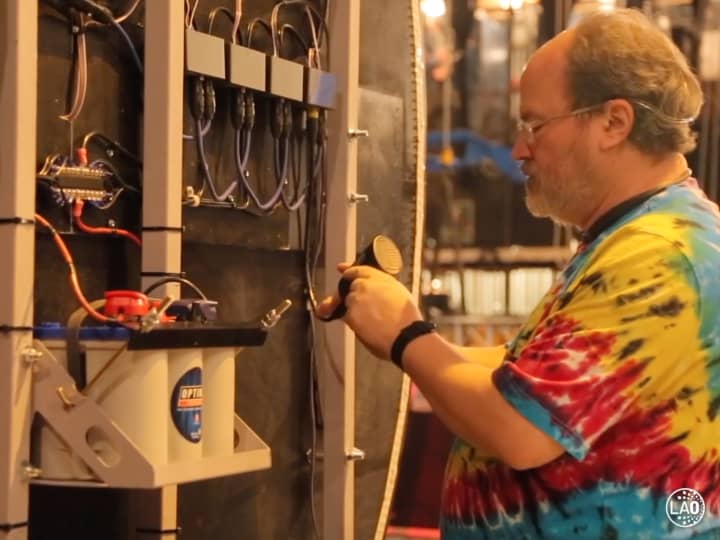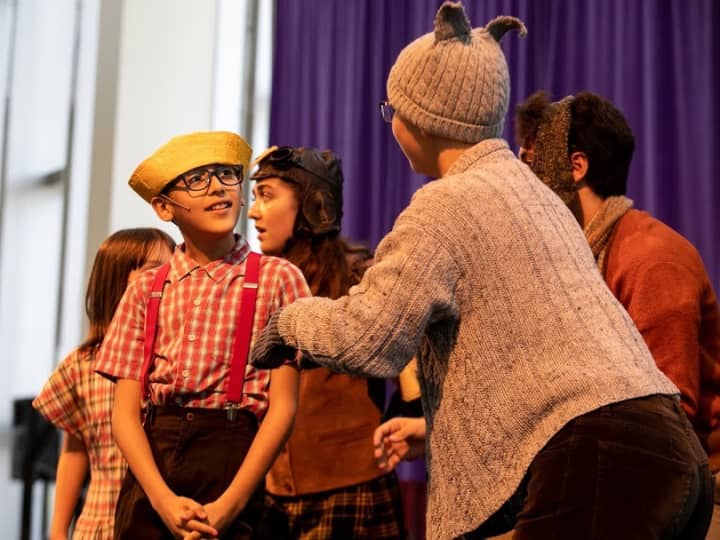Some people have lives that simply cry out to be turned into books, movies, graphic novels, songs... maybe even operas. Ada Lovelace (1815-1852) was one of them. By the age of 17, she was making her mark in a male-dominated field as a brilliant mathematician. She is considered to have written the first computer program and she may have been the first person to grasp the true extent of what computers might one day be able to do. Her father was the poet Lord Byron (famously described as “mad, bad and dangerous to know” by one of his many lovers), who died when she was a small girl. Her mother, hoping to prevent young Ada from taking after her father’s volatile artistic sensibilities, steered her firmly toward the study of mathematics and science, where her astonishing talents quickly became apparent.
This fall, Ada’s story will be told in operatic form in Edge of a Dream, a new work by composer Juhi Bansal and librettist Neil Aitken. It's LA Opera’s newest Secondary In-School Opera, created to be rehearsed, assembled and performed over a five-week period by students from ten local high schools. In deference to the restrictions of the pandemic era, the students will present the opera in an online format instead of in their classrooms.
The kids will be working with director Eli Villanueva as well as two professional singers in the leading roles, along with three musicians. Eli’s recent experience with the summer’s online Opera Camp will no doubt prove essential to the project’s success. “We honed down the process of finding the most efficient way to teach the kids the music, getting them excited about being part of the project, and helping their teachers evaluate their progress. We now have a set of instructions on how to do that.”

A portrait of Ada Lovelace.
The Opera Comes Together
Juhi and Neil, who first began collaborating as students at USC, had been sporadically piecing together an opera about Ada Lovelace over the years. But since it wasn’t a commissioned piece with concrete plans for performances, their other work took precedence. “We wanted to do it in a way that made sense,” says Juhi. “Ada’s story isn’t necessarily a big, grandly staged kind of a story, although you could probably do it that way. What made her story interesting to me is that it’s something that all students trying to find their path can relate to, particularly girls. It felt like it needed to be more of a community thing, something for schools. Somewhere along the way, I met Stacy Brightman (LAO’s Vice President of Connects) and began working with LA Opera, most recently in February with the cantata We Look to the Stars, which was part of the Eurydice Found festival. After that, I was catching up with Stacy on a Zoom call and Ada came up in our conversation. I told her a little bit about the opera I was working on with Neil. A few weeks later, Stacy asked to set up another Zoom call, this time with her whole team, to talk about putting Ada's story together as a school project.”
The more you know about Ada, the more you think "'wow, we should be talking about her more,’” says Neil. He knew about her through his research on mathematician Charles Babbage, who dreamed up the concept of the programmable computer (which he called the Analytical Engine). “Babbage was trying to come up with the idea of the computer in a world that didn’t have the context for it, that didn’t understand what its purpose might be. It was a very lonely experience for him. People were excited by the novelty of what he was proposing, but it wasn’t until he met Ada that he actually found someone who truly understood what he was trying to accomplish. What surprised him most was that it came in the form of Lord Byron’s 17-year-old daughter. Ada’s obsession with mathematics and the enthusiasm with which she jumped into the study of mathematical ideas made her the perfect person to have this interaction with Babbage. She began to ask questions that demonstrated a much deeper comprehension of what was going on. And that’s what this opera is about, that encounter."

Composer Juhi Bansal
“Babbage later asked her to translate an Italian review of his work. She did, and also appended her own notes, four times as long as the original article, going into far more detail and capturing what is effectively the first computer program. She also imagined the future of the machine as something that wouldn’t just calculate tables and produce scientific results but would also be a tool for creating art and music. That imaginative leap, much greater even than what Babbage had in mind, is what we celebrate in the opera.”
The opera's plot is framed by present-day scenes featuring Maria, a high school student puzzling over a questionnaire about what she wants to pursue as a career. Her father points out that she can do anything she dreams of, and tells her the story of Ada, a girl Maria’s age who made huge contributions to science. The opera then jumps to one of Babbage’s 19th-century salons, where Ada’s perceptive questions are initially drowned out by the (mostly male) scientists and intellectuals in attendance. This is where the high school performers come in, taking on the roles of the scientists and intellectuals. "All the societal peer pressures and anxieties, even our own internal anxieties about who we are, get voiced in that chorus,” notes Neil. Babbage gradually recognizes the girl’s extraordinary insight. In their subsequent conversation, their roles start to shift as to who is leading the conversation and what that might mean.
“For this project, we knew from the beginning that it was probably going to be done digitally,” remembers Juhi. “That made it an entirely different kind of proposition. I was thinking a little bit about how the story might play out on stage, but I also had to think about how the story was going to be delivered on a flat screen. We knew we were working in a tight set of parameters.
Finding the Right Musical Voice
“Because I want the students to have fun with the choral parts, they’re easy but layered in ways that I think are going to make it sound really interesting when everything comes together. Before we wrote anything, there was a lot of logistical planning and problem solving. The dramatic climax of the piece is a multi-part conversation where Ada’s trying to make her voice heard over the chorus of intellectuals, who are trying to ask their own questions. Babbage is kind of bouncing back and forth, trying to talk to all of them and getting frustrated. I remember really struggling with that section for a few days, knowing that everything would have to be recorded separately. I think it turned out really well, working within those tight parameters, but I won’t say it was easy.”
What does Edge of a Dream sound like? “I draw on Indian influences in my music a fair amount. It’s where I’m from and it’s the music I grew up listening to. For this project, I wanted to do that but not in a way that interfered with the story; Ada’s story is not that. But at the same time, that’s my voice as a composer. There are all these underscores and transitions that happen in between scenes; the performers get to do some improvisation and some aleatory music that’s not overtly Indian but has a couple of gestures and ideas from that. When you get to the musical numbers, those are straightforward song forms dictated by the text in a more traditional way. It’s scored for piano, violin and cello, and I love writing for a trio. Color is important to me as a composer, even when you have a small ensemble, and you can do so much with a trio."

Librettist Neil Aitken
“Ada’s struggle is all about being able to choose for herself. She has her own sound world that she’s living in, which is different from what everybody else lives in. Her vocal part sits in a particular register that’s always a little bit high, which brings a particular character to it. There are motives and themes and musical ideas, all of which create this character and this sense of Ada ‘lifting.’ It’s like her dreaming these abstract, beautiful things, which is very different from the slightly more dissonant, more grounded, heavier sound of everyone else around her.”
Hope and Inspiration
What does Juhi hope the students will take away from their experience with Edge of a Dream? “When Ada got involved with this, she was barely older than the students who are going to be doing the project, and she went so far beyond what everybody thought she could do. Who would have thought a 17-year-old in London in the 1830s could do this, a girl? Her work is amazing, and it still has impact. It's so important to choose your own path regardless of peer pressure and what people are saying around you. When you’re in school, that’s a big deal. It’s a huge part of the story. Another thing, much less overt: I think it’s really fascinating how her work brought together technical elements with a creative way of looking at the world. One of the things we bring into the opera is when Ada was six or seven years old, she would be inspired by birds and then start sketching flying machines, dreaming what they might be like, once again blending the technical with the artistic. You don't have to work exclusively in one or the other. You’re better at what you do when you bring in elements of both.”
Which, come to think about it, is exactly what Juhi and Neil have done in creating Edge of a Dream.
“What’s interesting to me is the way that Ada Lovelace has returned to popular attention in recent years,” remarks Neil. “There are societies of women programmers who commemorate Ada Lovelace Day every year as a celebration of women and technology. There is more awareness and discussion of the contributions that women make in science, engineering and technology, which is so often passed over or omitted from the history books. That’s another motivation for why we’re doing this opera about her.”
“Neil and I have wanted to tell Ada’s story for so long,” says Juhi. “One of the things she imagined was this idea of using a computer to create art. This was far beyond what anybody else saw at the time; they thought it was going to be a number crunching machine. The fact that we’re now creating this opera about her during COVID on a computer, to be recorded digitally and performed digitally, just seemed like it was a beautiful circle.”



